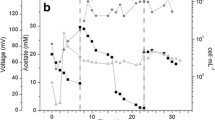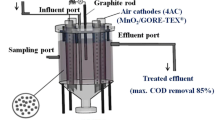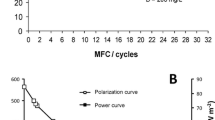Abstract
A mediator-less three-stage two-chamber microbial fuel cell (MFC) system was developed and operated continuously for more than 1.5 years to evaluate continuous power generation while treating artificial wastewater containing glucose (10 mM) concurrently. A stable power density of 28 W/m3 was attained with an anode hydraulic retention time of 4.5 h and phosphate buffer as the cathode electrolyte. An overall dissolved organic carbon removal ratio was about 85%, and coulombic efficiency was about 46% in this MFC system. We also analyzed the microbial community structure of anode biofilms in each MFC. Since the environment in each MFC was different due to passing on the products to the next MFC in series, the microbial community structure was different accordingly. The anode biofilm in the first MFC consisted mainly of bacteria belonging to the Gammaproteobacteria, identified as Aeromonas sp., while the Firmicutes dominated the anode biofilms in the second and third MFCs that were mainly fed with acetate. Cyclic voltammetric results supported the presence of a redox compound(s) associated with the anode biofilm matrix, rather than mobile (dissolved) forms, which could be responsible for the electron transfer to the anode. Scanning electron microscopy revealed that the anode biofilms were comprised of morphologically different cells that were firmly attached on the anode surface and interconnected each other with anchor-like filamentous appendages, which might support the results of cyclic voltammetry.








Similar content being viewed by others
References
Aelterman P, Rabaey K, Pham HT, Boon N, Verstraete W (2006) Continuous electricity generation at high voltages and currents using stacked microbial fuel cells. Environ Sci Technol 40:3388–3394
Amann RI (1995) In situ identification of micro-organisms by whole cell hybridization with rRNA-targeted nucleic acid probes. In: Akkerman ADL, van Elsas JD, de Bruijin FJ (eds) Molecular microbial ecology manual. Kluwer Academic, Dordrecht, pp 1–15
Amann RI, Binder BJ, Olson RJ, Chisholm SW, Devereux R, Stahl DA (1990) Combination of 16s rRNA-targeted oligonucleotide probes with flow cytometry for analyzing mixed microbial populations. Appl Environ Microbiol 56:1919–1925
APHA, AWWA, WEF (1998) Standard methods for examination of water and wastewater, 20th edn. APHA, AWWA, and WEF, Washington DC
Benz M, Schink B, Brune A (1998) Humic acid reduction by Propionibacterium freudenreichii and other fermenting bacteria. Appl Environ Microbiol 64:4507–4512
Bond DR, Lovley DR (2002) Reduction of Fe(III) oxide by methanogens in the presence and absence of extracellular quinones. Environ Microbiol 4:115–124
Bond DR, Lovley DR (2003) Electricity production by Geobacter sulfurreducens attached to electrodes. Appl Environ Microbiol 69:1548–1555
Bond DR, Holmes DE, Tender LM, Lovley DR (2002) Electrode reducing microorganisms that harvest energy from marine sediments. Science 295:483–485
Chaudhuri SK, Lovley DR (2003) Electricity generation by direct oxidation of glucose in mediator-less microbial fuel cells. Nature Biotechnol 21:1229–1232
Cheng S, Liu H, Logan BE (2006) Increased power generation in a continuous flow MFC with advective flow through the porous anode and reduced electrode spacing. Environ Sci Technol 40:2426–2432
Choo YF, Lee J, Chang IS, Kim BH (2006) Bacterial communities in microbial fuel cells enriched with high concentrations of glucose and glutamate. J Microbiol Biotechnol 16:1481–1484
Daims H, Bruehl A, Amann R, Schleifer KH, Wagner M (1999) The domain-specific probe EUB338 is insufficient for the detection of all bacteria: development and evaluation of a more comprehensive probe set. Syst Appl Microbiol 22:434–444
Davis F, Higson SPJ (2007) Biofuel cells—recent advances and applications. Biosens Bioelectron 22:1224–1235
Dojka MA, Hugenholtz P, Haack SK, Pace NR (1998) Microbial diversity in a hydrocarbon- and chlorinated-solvent-contaminated aquifer undergoing intrinsic bioremediation. Appl Environ Microbiol 64:3869–3877
Du Z, Li H, Gu T (2007) A state of the art review on microbial fuel cells: a promising technology for wastewater treatment and bioenergy. Biotechnol Adv 25:464–482
Falz KZ, Holliger C, Groβkopf R et al (1999) Vertical distribution of methanogens in the anoxic sediment of Rotsee (Switzerland). Appl Environ Microbiol 65:2402–2408
Fan Y, Hu H, Liu H (2007) Enhanced coulombic efficiency and power density of air-cathode microbial fuel cells with an improved cell configuration. J Power Sources 171:348–354
Gorby YA, Yanina S, McLean JS et al (2006) Electrically conductive bacterial nanowires produced by Shewanella oneidensis strain MR-1 and other microorganisms. Proc Natl Acad Sci U S A 103:11358–11363
He Z, Minteer SD, Angenent LT (2005) Electricity generation from artificial wastewater using an upflow microbial fuel cell. Environ Sci Technol 39:5262–5267
Ishii S, Shimoyama T, Hotta Y, Watanabe K (2008) Characterization of a filamentous biofilm community established in a cellulose-fed microbial fuel cell. BMC Microbiology 5:6. doi:https://doi.org/10.1186/s1471218086
Jong BC, Kim BH, Chang IS, Liew PW, Choo YF, Kang GS (2006) Enrichment, performance, and microbial diversity of a thermophilic mediatorless microbial fuel cell. Environ Sci Technol 40:6449–6454
Karakashev D, Batstone DJ, Trably E, Angelidaki I (2006) Acetate oxidation is the dominant methanogenic pathway from acetate in the absence of Methanosaetaceae. Appl Environ Microbiol 72:5138–5141
Kim JR, Min B, Logan BE (2005) Evaluation of procedures to acclimate a microbial fuel cell for electricity production. Appl Microbiol Biotechnol 68:23–30
Kim GT, Webster G, Wimpenny JWT, Kim BH, Kim HJ, Weightman AJ (2006) Bacterial community structure, compartmentalization and activity in a microbial fuel cell. J Appl Microbiol 101:698–710
Kim JR, Jung SH, Regan JM, Logan BE (2007) Electricity generation and microbial community analysis of alcohol powered microbial fuel cells. Bioresour Technol 98:2568–2577
Lane DJ (1991) 16S/23S rRNA sequencing. In: Stackebrandt E, Goodfellow M (eds) Nucleic acid techniques in bacterial systematics. Wiley, Chichester, pp 115–175
Liu H, Logan BE (2004) Electricity generation using an air-cathode single chamber microbial fuel cell in the presence and absence of a proton exchange membrane. Environ Sci Technol 38:4040–4046
Liu H, Ramnarayanan R, Logan BE (2004) Production of electricity during wastewater treatment using a single chamber microbial fuel cell. Environ Sci Technol 38:2281–2285
Liu H, Cheng S, Logan BE (2005) Production of electricity from acetate or butyrate using a single-chamber microbial fuel cell. Environ Sci Technol 39:658–662
Logan BE, Regan JM (2006) Electricity-producing bacterial communities in microbial fuel cells. Trends Microbiol 14:512–518
Madigan MT, Martinko JM (2006) Brock biology of microorganisms, 11th edn. Pearson Prentice Hall, Upper Saddle River, pp 64–66
Manohar AK, Bretschger O, Nealson KH, Mansfeld F (2008) The polarization behavior of the anode in a microbial fuel cell. Electrochim Acta 53:3508–3513
Manz W, Amann R, Ludwig W, Wagner M, Schleifer KH (1992) Phylogenetic oligodeoxynucleotide probes for the major subclasses of proteobacteria: problems and solutions. Syst Appl Microbiol 15:593–600
Meier H, Amann R, Ludwig W, Schleifer KH (1999) Specific oligonucleotide probes for in situ detection of a major group of gram-positive bacteria with low DNA G+C content. Syst Appl Microbiol 22:186–196
Min B, Logan BE (2004) Continuous electricity generation from domestic wastewater and organic substrates in a flat plate microbial fuel cell. Environ Sci Technol 38:5809–5814
Miura Y, Hiraiwa MN, Ito T, Itonaga T, Watanabe Y, Okabe S (2007) Bacterial community structures in MBRs treating municipal wastewater: relationship between community stability and reactor performance. Water Res 41:627–637
Moon H, Chang IS, Kim BH (2006) Continuous electricity production from artificial wastewater using a mediator-less microbial fuel cell. Bioresour Technol 97:621–627
Nevin KP, Richter H, Covalla SF, Johnson JP, Woodard TL, Orloff AL, Jia H, Zhang M, Lovley DR (2008) Power output and columbic efficiencies from biofilms of Geobacter sulfurreducens comparable to mixed community microbial fuel cells. Environ Microbiol 10:2505–2514
Okabe S, Satoh H, Watanabe Y (1999) In situ analysis of nitrifying biofilms as determined by in situ hybridization and the use of microelectrodes. Appl Environ Microbiol 65:3182–3191
Park HS, Kim BH, Kim HS, Kim GT, Chang IS, Park YK, Chang HI (2001) A novel electrochemically active and Fe (III)-reducing bacterium phylogenetically related to Clostridium butyricum isolated from a microbial fuel cell. Anaerobe 7:297–306
Pham CA, Jung JS, Phung NT, Lee J, Chang IS, Kim BH, Yi H, Chun J (2003) A novel electrochemically active and Fe (III)-reducing bacterium phylogenetically related to Aeromonas hydrophila isolated from a microbial fuel cell. FEMS Microbiol Lett 223:129–134
Rabaey K, Verstraete W (2005) Microbial fuel cells: novel biotechnology for energy generation. Trends Biotechnol 23:291–298
Rabaey K, Lissens G, Siciliano SD, Verstraete W (2003) A microbial fuel cell capable of converting glucose to electricity at high rate and efficiency. Biotechnol Lett 25:1531–1535
Rabaey K, Boon N, Siciliano SD, Verhaege M, Verstraete W (2004) Biofuel cells select for microbial consortia that self-mediate electron transfer. Appl Environ Microbiol 70:5373–5382
Rabaey K, Clauwaert P, Aelterman P, Verstraete W (2005a) Tubular microbial fuel cells for efficient electricity generation. Environ Sci Technol 39:8077–8082
Rabaey K, Boon N, Hofte M, Verstraete W (2005b) Microbial phenazine production enhances electron transfer in biofuel cells. Environ Sci Technol 39:3401–3408
Rabaey K, Van de sompel K, Maignien L, Boon N, Aelterman P, Clauwaert P, De schamphelaire L, Pham HT, Vermeulen J, Verhaege M, Lens P, Verstraete W (2006) Microbial fuel cells for sulfide removal. Environ Sci Technol 40:5218–5224
Raskin L, Stromley JM, Rittmann BE, Stahl DA (1994) Group specific 16S rRNA hybridization probes to describe natural communities of methanogens. Appl Environ Microbiol 60:1232–1240
Reguera G, McCarthy KD, Mehta T, Nicoll JS, Tuominen MT, Lovley DR (2005) Extracellular electron transfer via microbial nanowires. Nature 435:1098–1101
Saito N, Nei M (1987) The neighbor-joining method; a new method for reconstructing phylogenetic trees. Mol Biol Evol 4:406–425
ter Heijne A, Hamelers HVM, Buisman CJN (2007) Microbial fuel cell operation with continuous biological ferrous iron oxidation of the catholyte. Environ Sci Technol 41:4130–4134
Thompson JD, Higgins DG, Gibson TJ (1994) CLUSTAL W; improving the sensitivity of progressive multiple sequence alignment through sequence weighting, position-specific gap penalties and weight matrix choice. Nucleic Acids Res 22:4673–4680
Torres CI, Marcus AK, Rittmann BE (2007) Kinetics of consumption of fermentation products by anode-respiring bacteria. Appl Microbiol Biotechnol 77:689–697
Zinder SH, Koch M (1984) Non-aceticlastic methanogenesis from acetate: acetate oxidation by a thermophilic syntrophic coculture. Arch Microbiol 138:263–272
Acknowledgement
This work was partially supported by the twenty-first century COE Program “Sustainable Metabolic System of Water and Waste for Area-Based Society” from the Ministry of Education, Science, and Culture of Japan and the funding for Basic and Applied Researches on Construction Technologies from the Ministry of Land, Infrastructure, Transport, and Tourism of Japan. K. Chung was financially supported by the twenty-first century COE Program.
Author information
Authors and Affiliations
Corresponding author
Electronic supplementary material
Rights and permissions
About this article
Cite this article
Chung, K., Okabe, S. Continuous power generation and microbial community structure of the anode biofilms in a three-stage microbial fuel cell system. Appl Microbiol Biotechnol 83, 965–977 (2009). https://doi.org/10.1007/s00253-009-1990-z
Received:
Revised:
Accepted:
Published:
Issue Date:
DOI: https://doi.org/10.1007/s00253-009-1990-z




